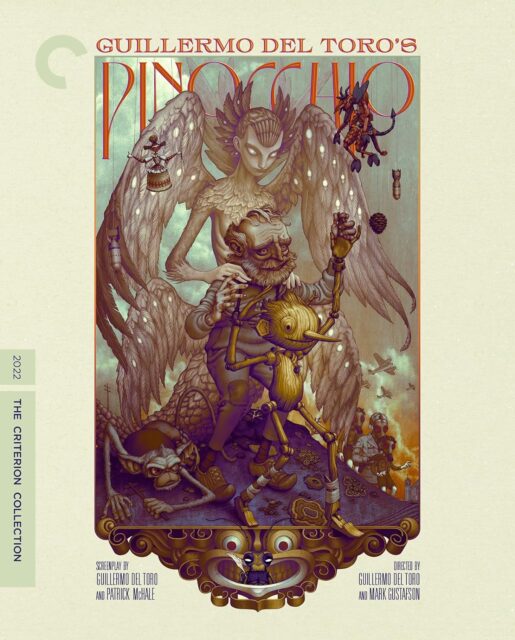
The post Home Video Hovel: Guillermo del Toro’s Pinocchio, by Rudie Obias appeared first on Battleship Pretension.
Although there are many versions of the Pinocchio story, from the classic Walt Disney animated feature to Roberto Benigni’s 2002 film, there has to be a good reason to make a new one — especially since it’s a story that most people know already. In fact, Guillermo del Toro’s Pinocchio opens with Cricket (voiced by Ewan McGregor) telling the audience, “It’s a story you may think you know, but you don’t. Not really.” And in some ways, no truer statement has ever been said.
(For the sake of brevity) Pinocchio receives a Criterion Collection release with a 4K digital master of the stop-motion animated film and a Dolby Atmos soundtrack. And while Pinocchio is readily streamable on Netflix, it’s great that there’s a physical copy available for film enthusiasts and del Toro fans.
Co-written by del Toro and Patrick McHale and co-directed by del Toro and Mark Gustafson, Pinocchio follows a lonesome and very drunk carpenter named Geppetto (voiced by David Bradley) who creates a boy out of wood after his son Carlo (voiced by Gregory Mann) is killed in a bombing in Fascist Italy during the 1930s. After a Wood Sprite (voiced by Tilda Swinton) brings Pinocchio (also voiced by Mann) to life, he must learn to be a real boy.
That’s the story most of us already know. But what makes this film different from other versions is that it’s also about Geppetto learning to accept Pinocchio as his son, while being open to love again.
While Pinocchio has the charm, curiosity and wit of a children’s film, its darker elements are disturbing enough for adults like this writer. Set aside Fascism in Italy and a country on the brink of war but how the film handles death is so grisly that it’s unclear (at least to this writer), if children will actually get what’s going on. Since Pinocchio isn’t a real boy, then he can’t be killed (one of a few Jesus Christ metaphors throughout the film).
For instance, Pinocchio is run over by a speeding truck and instead of dying, he’s placed in a limbo afterworld where Death (also voiced by Swinton) tells him he can come back to life again and again because he’s not human. That’s a very big idea for most adults to grapple with but it’s almost a lark in the movie. The film is certainly dark but throw in Fascism, slavery, war, child soldiers, and a cruel, cruel world and it seems like it’s a lot for parents to explain all at once to a child.
As far as the release itself, the packaging is very clever. After you pull the digipak out of its sleeve, you have to pull away an extended paper tree branch to open it up. Once unfolded, it reveals Pinocchio with a long nose spilled over the box. It comes with two essays from film critic Matt Zoller Seitz and author Cornelia Funke about animation and fairy tales, respectively, which are both available to read on Criterion’s website. There are a number of bonus features about the film’s production from storyboards to Zoom meetings (the film was made during the pandemic) to lengthy featurettes on the detail and painstaking process of stop motion animation.
At one point, del Toro calls the production “painfully human,” which seems very apt considering that it took three months of animation to capture 30 seconds of film. For that alone, Guillermo del Toro’s Pinocchio is a marvel and triumph of animation and filmmaking. You can get a deeper appreciation of the film with the Criterion Collection release than just streaming it on Netflix.
The post Home Video Hovel: Guillermo del Toro’s Pinocchio, by Rudie Obias first appeared on Battleship Pretension.
The post Home Video Hovel: Guillermo del Toro’s Pinocchio, by Rudie Obias appeared first on Battleship Pretension.







